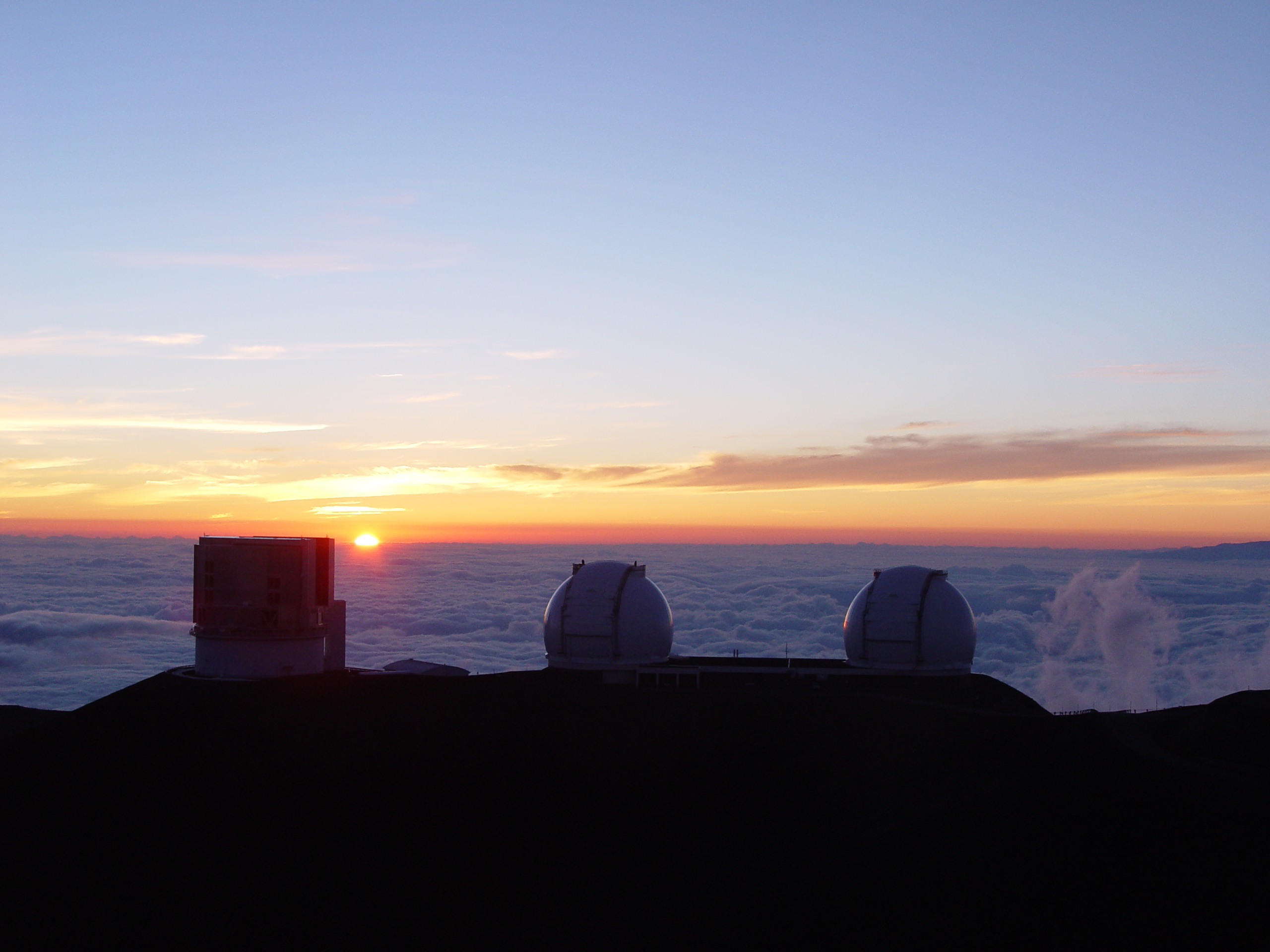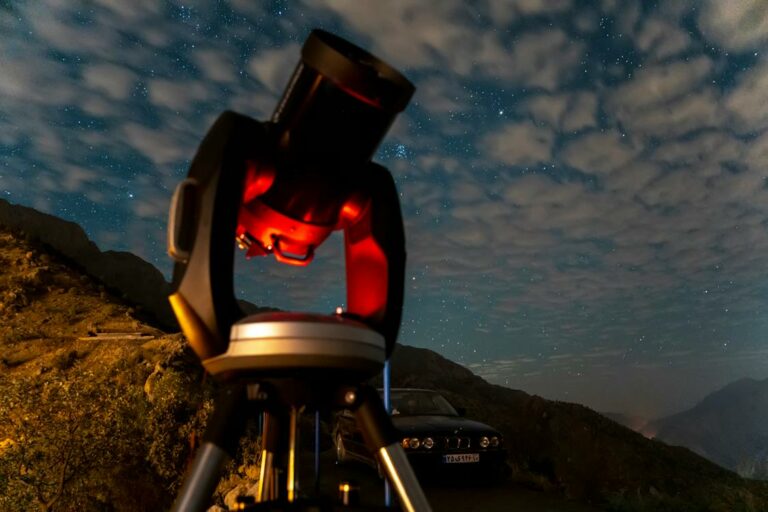In this post, we will be exploring some of the largest telescopes on Earth and their significance in the field of astronomy.
These behemoths of technology represent the cutting edge of our quest to understand the universe and they continue to push the boundaries of our knowledge.
Lets explore the following Earth’s Largest telescopes:
- Keck Observatory
- Gran Telescopio Canarias (GTC)
- Large Binocular Telescope (LBT)
- Subaru Telescope
- The Atacama Large Millimeter/submillimeter Array (ALMA)
Also, be sure to check out some incredible space-based telescopes HERE.
Keck Observatory
Location and History of the Keck Observatory
Located on the summit of Mauna Kea in Hawaii, the Keck Observatory ranks as one of the world’s premier astronomical facilities and largest telescopes in the world.
The name stems from its primary backers, the W.M. Keck Foundation. In the mid-1990s, construction of the two Keck telescopes was completed, and the observatory has since led the way in astronomical research and discovery.
A joint venture between the California Institute of Technology and the University of California, the Keck Observatory is available to astronomers worldwide for both observational and theoretical research.
Size and Technical Specifications of Keck I and II That Make It One of the Largest Telescopes
- Primary Mirror Diameter: 10 meters (each)
- Type: Segmented Mirror Telescopes
- Location: Mauna Kea Observatories, Hawaii, USA
- Operational Since:
- Keck I: 1993
- Keck II: 1996
- Wavelength Coverage: Optical and Infrared
- Observing Modes: Imaging, Spectroscopy, Interferometry
Common Features:
- Mirror Segments: Both telescopes have segmented primary mirrors composed of hexagonal mirror segments.
- Adaptive Optics: Keck Observatory is equipped with adaptive optics systems to correct for atmospheric distortions.
- Instruments: Various scientific instruments and spectrographs are available for observations.
Keck I:
- Instrumentation: High-Resolution Echelle Spectrometer (HIRES), Near-Infrared Camera (NIRC)
Keck II:
- Instrumentation: Echellette Spectrograph and Imager (ESI), Multi-Object Spectrometer for Infrared Exploration (MOSFIRE)
Contributions to Astronomy and Scientific Breakthroughs
Over the years, as one of the largest telescopes on Earth, the Keck Observatory has contributed numerous groundbreaking discoveries that have enhanced our understanding of the universe.
Some of the most notable accomplishments include:
Discovering the first exoplanet outside our solar system, orbiting a sun-like star, which demonstrated the existence of other planetary systems beyond our own.
Discovering dark energy, which is believed to be accountable for the universe’s accelerated expansion.
Discovering a massive black hole at the center of the Milky Way has provided new insights into the evolution of galaxies.
Studying supernovae, which has revealed new information about the life cycles of stars and the universe’s evolution.
Studying distant galaxies, which has provided new insights into the universe’s formation and evolution.

Gran Telescopio Canarias (GTC)
Location and History of Gran Telescopio Canarias
Situated on the island of La Palma in the Canary Islands, Spain, the Gran Telescopio Canarias (GTC), or Great Canary Telescope, was constructed through a collaboration between Spain and Mexico and opened officially in 2009.
The GTC is the world’s largest single-aperture optical telescope and has become one of the most significant astronomical facilities globally.
Astronomers from around the world are welcome to use the GTC for a diverse range of observational and theoretical research.
Its large size and advanced instrumentation make it ideal for detecting faint and far-off celestial objects, while its location on La Palma offers some of the most unobstructed and steady observing conditions globally.
Size and Technical Specifications That Make GTC the World's Largest Single-aperture Optical Telescope
- Primary Mirror Diameter: 10.4 meters
- Type: Single-Aperture Optical Telescope
- Location: Roque de los Muchachos Observatory, La Palma, Spain
- Operational Since: 2009
- Wavelength Coverage: Optical and Infrared
- Observing Modes: Imaging, Spectroscopy, Polarimetry
Common Features:
- Mirror Type: Segmented Mirror
- Mirror Segments: 36 hexagonal mirror segments
- Adaptive Optics: Equipped with adaptive optics systems to correct for atmospheric turbulence.
Instruments:
- OSIRIS (Optical System for Imaging and low-Intermediate-Resolution Integrated Spectroscopy): Visible and near-infrared camera and spectrograph.
- CanariCam: Infrared camera and spectrograph.
- GTC High-Resolution Spectrograph (GTC-HRS): High-resolution optical spectrograph.
- MIRADAS (Mid-resolution InfRAreD Astronomical Spectrograph): Mid-resolution near-infrared spectrograph.
Contributions to Astronomy and Scientific Breakthroughs
Since it was established in 2009, the Gran Telescopio Canarias (GTC) has played a pivotal role in advancing astronomical research and scientific discovery and has achieved several notable accomplishments as one of Earth’s largest telescopes, including:
The discovery of many exoplanets, including some of the smallest and closest to their host stars. This has enabled astronomers to better understand the formation and evolution of planetary systems beyond our own.
The study of distant galaxies, including the observation of some of the earliest galaxies in the universe. This has helped to shed light on the formation and evolution of galaxies over cosmic time.
The observation of supernovae, which have provided new insights into the life cycles of stars and the evolution of the universe. These observations have allowed scientists to better understand the physical processes that govern the behavior of stars and the cosmos.
The study of the atmospheres of hot Jupiter exoplanets, which have provided new insights into the formation and evolution of planetary systems. These observations have given astronomers important clues about the formation of planets and their atmospheres.
The observation of comets, asteroids, and other small bodies in the solar system, providing new insights into the formation and evolution of our own solar system. This has allowed scientists to better understand the early stages of our solar system and the processes that led to the formation of planets and other celestial bodies.

Large Binocular Telescope (LBT)
Location and History of the Large Binocular Telescope
The Large Binocular Telescope (LBT) represents a significant milestone in astronomical observation, with its construction marking a collaboration among institutions from the United States, Italy, and Germany.
This collaborative effort has positioned the LBT as a forefront astronomical instrument, contributing to a diverse range of scientific discoveries and investigations since its inception.
Situated atop Mount Graham in southeastern Arizona, the LBT consists of two colossal 8.4-meter primary mirrors sharing a common mount.
The telescope became operational in 2005 with the installation of its first mirror.
Size and Technical Specifications of the LBT That Make it One of the Largest Telescopes
- Primary Mirror Diameter: 8.4 meters (each, two mirrors)
- Type: Binocular Optical and Infrared Telescope
- Location: Mount Graham, Arizona, USA
- Operational Since: The first primary mirror became operational in 2005.
- Wavelength Coverage: Optical and Infrared
- Observing Modes: Imaging, Spectroscopy, Interferometry
Common Features:
- Mirror Type: Two 8.4-meter primary mirrors on a single mount.
- Adaptive Optics: The LBT is equipped with adaptive optics for correcting atmospheric distortions.
Instruments:
- LUCI (LBT Utility Camera and Infrared Imager): Infrared camera and spectrograph.
- MODS (Multi-Object Double Spectrographs): Dual optical spectrographs.
- PEPSI (Potsdam Echelle Polarimetric and Spectroscopic Instrument): High-resolution optical spectrograph.
Contributions to Astronomy and Scientific Breakthroughs
Since its inauguration in 2005, the Large Binocular Telescope (LBT) has made a number of important contributions to astronomical research and scientific discovery, including:
Advancements in exoplanet research through the telescope’s high-resolution imaging and spectroscopic capabilities have allowed astronomers to study the atmospheres of exoplanets in detail and provide new insights into their formation and evolution.
The study of a wide range of astronomical objects, such as distant galaxies, nearby stars, and the structure of the universe itself.
Involvement in large survey projects, including the Large Binocular Telescope LUCI Near-Infrared Spectroscopic Survey, which has been used to study the evolution of galaxies and the formation of stars and planetary systems, leading to new discoveries in the field of astronomy.

Subaru Telescope
Location and History of the Subaru Telescope
The Subaru Telescope, located on Mauna Kea in Hawaii, is known as one of the world’s best astronomical observing sites due to its high altitude, and dry and stable conditions that provide excellent viewing conditions for astronomers.
Operated by the National Astronomical Observatory of Japan, the Subaru Telescope was commissioned in 1999 and named after the Pleiades star cluster, known as “Subaru” in Japanese.
The telescope was designed to be one of the largest optical-infrared telescopes globally and has consistently upheld this reputation throughout its years of operation.
Constructed to replace the Kashiocam, an older Japanese telescope that operated on Mauna Kea from the 1970s to the late 1990s, the Subaru Telescope was a significant international collaboration between Japanese, American, and Canadian scientists and engineers.
Size and Technical Specifications
- Primary Mirror Diameter: 8.2 meters
- Type: Single-Aperture Optical and Infrared Telescope
- Location: Mauna Kea Observatories, Hawaii, USA
- Operational Since: 1999
- Wavelength Coverage: Optical and Infrared
- Observing Modes: Imaging, Spectroscopy
Common Features:
- Mirror Type: Single primary mirror.
- Adaptive Optics: Equipped with adaptive optics systems for high-resolution observations.
Instruments:
- Suprime-Cam: Optical imaging camera.
- FOCAS (Faint Object Camera and Spectrograph): Optical spectrograph and camera.
- HSC (Hyper Suprime-Cam): Large field-of-view optical camera.
- IRCS (Infrared Camera and Spectrograph): Infrared camera and spectrograph.
Contributions to Astronomy and Scientific Breakthroughs
Its advanced instrumentation, such as the Hyper Suprime-Cam, has enabled astronomers to observe and analyze galaxies in the early universe, shedding light on the processes that led to the formation of galaxies.
Contributed valuable data on the atmospheres of exoplanets, aiding in the quest to identify potentially habitable worlds and expanding our understanding of planetary systems beyond our solar system.
Subaru Strategic Survey and the Hyper Suprime-Cam Subaru Strategic Program, has facilitated the mapping of dark matter structures. By observing millions of galaxies, the telescope has provided crucial data for understanding the distribution and evolution of dark matter in the universe.
The telescope has been utilized in surveys to detect and monitor supernovae and other transient phenomena, contributing to our understanding of stellar evolution and the dynamic nature of the cosmos.
Subaru’s capabilities in high-resolution imaging and spectroscopy, facilitated by instruments like Suprime-Cam and the Faint Object Camera and Spectrograph (FOCAS), have been pivotal in gravitational lensing studies. Observations of lensed objects have provided insights into dark matter distribution and the nature of distant galaxies, contributing significantly to our understanding of the cosmos.

The Atacama Large Millimeter/submillimeter Array (ALMA)
Location and History of the Atacama Large Millimeter/submillimeter Array
Located on the Chajnantor plateau in the Atacama Desert of northern Chile, the Atacama Large Millimeter/submillimeter Array (ALMA) comprises 66 high-precision antennas spread out over approximately 16 kilometers.
Its construction began in 2003, and it was inaugurated in March 2013, as a collaboration between several international partners, including the European Southern Observatory (ESO), the National Astronomical Observatory of Japan (NAOJ), and the National Radio Astronomy Observatory (NRAO) in the United States.
ALMA is an advanced astronomical observatory designed to study the universe in millimeter and submillimeter wavebands.
These wavelengths are critical for studying the early universe, and the formation of galaxies, stars, and planetary systems.
ALMA’s location in the high and dry Atacama Desert, which offers some of the clearest skies in the world, makes it an ideal site for these observations.
Size and Technical Specifications That Make ALMA One of the World's Largest Telescopes
- Location: Atacama Desert, northern Chile
- Operational Since: The first scientific observations began in 2011.
- Frequency Range: Covers millimeter and submillimeter wavelengths (0.3 to 9.6 mm).
- Observing Modes: Interferometry for high-angular resolution imaging and spectroscopy.
Common Features:
- Antennas: ALMA consists of an array of up to 66 high-precision antennas.
- Configurations: The antennas can be configured in different array arrangements to achieve different levels of angular resolution.
- High and Dry Location: Located at an elevation of around 5,000 meters (16,400 feet) for optimal observation conditions.
Instruments:
- Receivers: Various receivers cover different frequency bands, allowing observations across a wide range of wavelengths.
- Correlator: A specialized supercomputer correlates signals from the antennas, enabling high-resolution imaging.
Contributions to Astronomy and Scientific Beakthroughs
Revolutionized radio astronomy by providing unprecedented sensitivity and resolution at millimeter and submillimeter wavelengths. Its 66 high-precision antennas work in unison to capture detailed images of celestial objects, enabling breakthroughs in our understanding of the cold and obscured regions of the universe.
Allowed astronomers to study the centers of galaxies, including our own Milky Way. The telescope’s observations have unveiled the dynamics of massive black holes and the distribution of molecular gas in galactic nuclei, providing crucial insights into the formation and evolution of galaxies.
Facilitated the detection of complex organic molecules in space. By studying these molecules in star-forming regions and protoplanetary disks, ALMA contributes to our understanding of the chemistry that precedes the formation of life.
Advanced our knowledge of star and planet formation by studying protostellar disks. It has captured intricate details of these disks, where planets form, shedding light on the processes governing the birth of solar systems and planetary bodies.
Submillimeter wavelengths has allowed it to map cosmic dust and grains in various environments, from nearby star-forming regions to distant galaxies. This capability provides essential data for understanding the role of dust in the formation of stars, planets, and galaxies throughout cosmic history.

The world’s largest telescopes have greatly advanced our understanding of the universe and have made many significant scientific discoveries. From the Mauna Kea Observatories in Hawaii to the Atacama Large Millimeter/submillimeter Array (ALMA) in Chile, these telescopes represent the pinnacle of human technological achievement in the field of astronomy.

Andrew
With years of experience and a passion for exploring the cosmos, I want to be your go-to destination for all things celestial. My mission is to bring the wonders of the universe to your fingertips and demonstrate how the art of stargazing and telescope therapy can nurture not only your astronomical curiosity but also your mental health. Explore the cosmos with me and discover the profound connection between the night sky and your inner peace.








+ There are no comments
Add yours